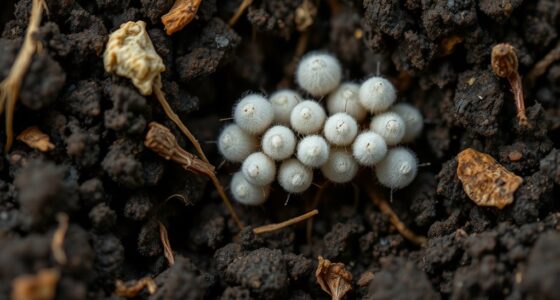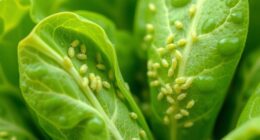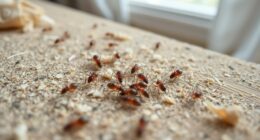If your houseplants show discolored or transparent patches on leaves, winding trails, or tiny dark frass particles, you might have a leaf miner problem. Watch for distorted, curled, or uneven growth and sticky honeydew deposits. You could also notice small larvae beneath the leaf surface or fine tunnels inside leaves. These signs indicate an active infestation that weakens your plant. Keep exploring for more tips to effectively manage and prevent leaf miners.
Key Takeaways
- Look for winding, serpentine trails and discolored, transparent patches on leaves indicating larvae tunneling inside.
- Check for tiny larvae visible within leaf tissue or under peeling layers.
- Notice sticky honeydew residues and frass particles on leaves or soil, signs of active infestation.
- Observe leaf deformation, curling, yellowing, or premature leaf drop caused by internal damage.
- Detect overall plant stress, such as wilting, weakness, and increased vulnerability to other pests.
Discolored or Transparent Leaf Areas
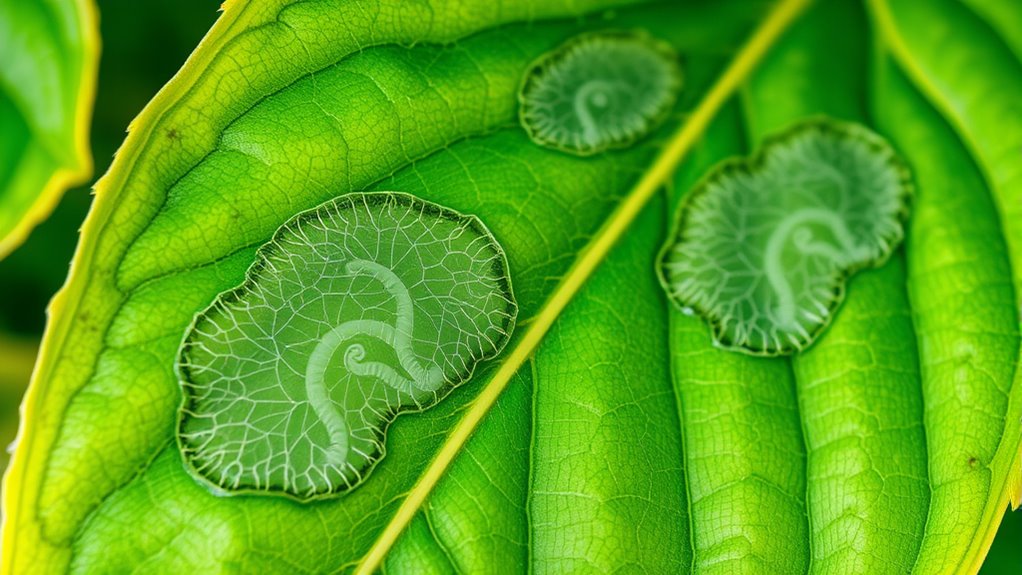
When your houseplants develop discolored or transparent patches on their leaves, it’s often a sign of leaf miner activity. These tiny pests lay eggs inside the leaf tissue, and as the larvae grow, they create tunnels that damage the plant’s cells. This disrupts normal pigmentation, causing areas to turn translucent or yellowed. Recognizing these patches early helps you catch the problem before it worsens. The leaf miner lifecycle is brief but impactful, with larvae tunneling beneath the surface. Natural predators, like certain parasitic wasps, can help control infestations by targeting the leaf miner larvae. However, if you notice these damaged areas, it’s best to act quickly to prevent further damage and consider integrated pest management strategies to keep your houseplants healthy. Regularly inspecting your plants and practicing preventative measures can also minimize the risk of infestation.
Winding or Serpentine Trails on Leaves
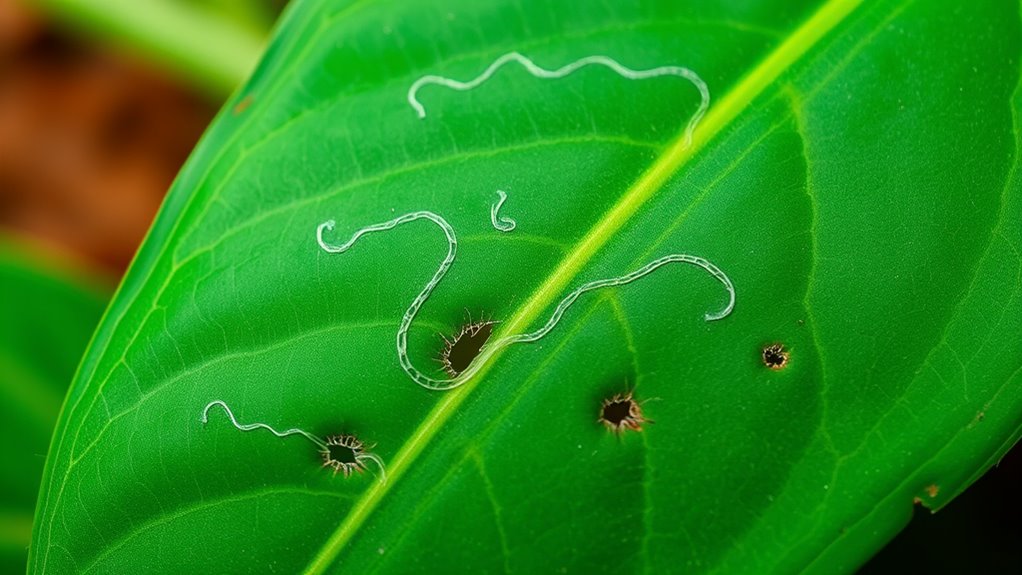
You’ll notice winding or serpentine trails on your plant’s leaves, which are clear signs of leaf miner activity. These trails are visible as thin, winding lines that cut through the leaf tissue. As the damage progresses, the leaf’s structure may weaken or become distorted around these trails. Implementing pest management techniques promptly can help prevent further damage and protect your houseplants.
Visual Identification of Trails
Winding or serpentine trails on houseplant leaves are clear signs of leaf miner activity. These trails are formed as larvae tunnel between the leaf’s surfaces, creating winding lines that are often visible from the outside. To identify these trails, closely examine both the upper and lower leaf surfaces for thin, light-colored streaks or tunnels. Recognizing these signs early helps you understand the leaf miner lifecycle and take prompt action. Prevention methods include inspecting new plants before introducing them to your home, maintaining plant health, and removing affected leaves. By catching these trails early, you can prevent further infestation and reduce damage to your houseplants. Regular inspection and good hygiene are key to managing leaf miner activity effectively. Additionally, understanding pest identification is essential for choosing the most effective control methods.
Damage to Leaf Structure
The visible winding or serpentine trails on leaves are direct evidence of leaf miner damage, indicating that larvae have tunneled through the leaf tissue. This activity causes significant leaf tissue damage and structural deterioration, weakening your plant’s overall health. As the larvae burrow, they disrupt the leaf’s natural structure, making it more fragile and prone to further harm. You may feel a sense of loss seeing your plant’s once vibrant foliage marred by these trails. The damage can spread quickly, affecting photosynthesis and plant vitality. Additionally, understanding cybersecurity vulnerabilities associated with plant care apps or online resources can help you stay protected while seeking advice.
Be alert to:
- The gradual decline of leaf strength
- Unattractive, winding scars ruining leaf beauty
- Increased vulnerability to disease
- Reduced plant vigor
- Emotional distress over your plant’s health
Presence of Small, Frass-Like Particles
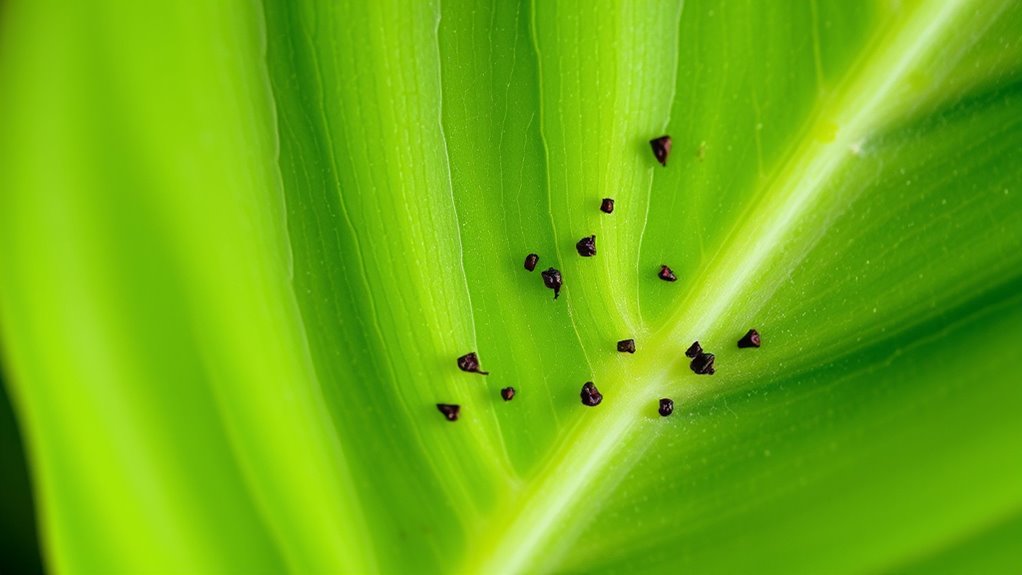
You might notice tiny, dark particles on your plant’s leaves or soil. These frass-like particles are often a sign that leaf miners have been feeding inside the leaves. When you see an accumulation of these small debris, it’s time to investigate further for possible infestation. Utilizing air purifiers can help improve indoor air quality, reducing allergens and odors that might stress your plants and compromise their health.
Tiny Particle Appearance
Small, frass-like particles often appear on the leaves or soil of your houseplants when leaf miners are active. These tiny particles are evidence of their activity and mark a stage in the infestation lifecycle. As leaf miner behavior progresses, these small, dark specks are expelled from their tunnels, signaling that larvae are feeding beneath the surface. Spotting these particles can evoke concern, as it indicates a developing problem. You might feel urgency to act, worry about plant health, or frustration with the ongoing infestation. Recognizing these signs early can help you respond swiftly. Understanding insect feeding patterns can help in identifying and managing infestations effectively.
Frass Accumulation Signs
Frass accumulation is a clear sign that leaf miners are actively feeding beneath your houseplant’s surface. You may notice tiny, frass-like particles on the leaf surface or in the crevices, indicating ongoing infestation. This is a key step in leaf miner detection and often signals the beginning of plant health decline if untreated. To better understand, consider this visual:
| Frass Location | Particle Size | Damage Signs |
|---|---|---|
| Along leaf veins | Tiny, granular | Wilting or yellowing leaves |
| Inside leaf mines | Small, dark specks | Leaf distortion |
| On leaf surface | Dispersed | Reduced foliage vigor |
If you see these signs, act quickly to prevent further damage and protect your houseplant’s health.
Distorted or Curled Leaf Edges
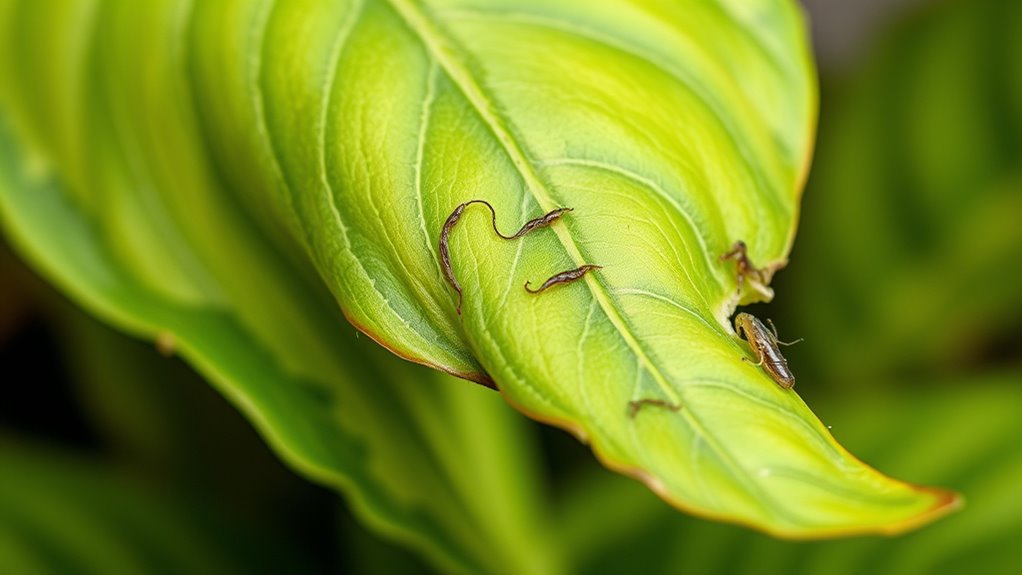
Distorted or curled leaf edges are a common sign that leaf miners are active inside your houseplants. You might notice the edges curling inward or the leaf surface developing uneven textures. These changes often accompany leaf texture changes and petiole swelling, signaling internal damage. You may feel a sense of loss as your plant’s appearance deteriorates. Look out for:
- Uneven leaf surfaces that feel rough or bumpy
- Edges curling inward or outward
- Soft, mushy spots developing on leaves
- Petioles swelling or becoming distorted
- Overall decline in leaf vigor and resilience
These symptoms indicate that leaf miners are feeding within your plant tissues, disrupting normal growth. Early detection is vital to prevent further damage and preserve your houseplant’s health. Recognizing plant pests early can help you take effective action to protect your greenery.
Sticky Residue or Honeydew Deposits
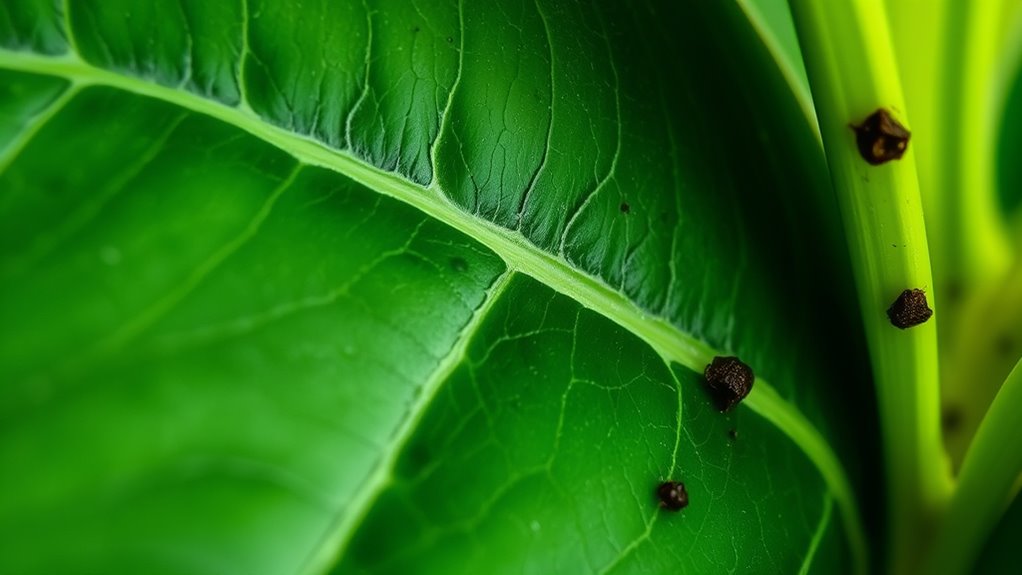
You might notice a sticky surface on your plant’s leaves or stems, indicating honeydew buildup. This residue often attracts sooty mold, which can darken the foliage. Keeping an eye out for these signs helps you catch leaf miner problems early. Additionally, dog names can sometimes be inspired by the pests’ characteristics or the plant’s environment.
Sticky Surface Formation
A sticky surface on your houseplant’s leaves is a telltale sign of leaf miner activity. This sticky residue, often called honeydew, is a clear indicator of leaf miner symptoms and ongoing houseplant damage. You might notice this slick coating accompanied by a weakened plant and dull foliage. It’s heartbreaking to see your plant struggle. Be alert for these signs:
- Shiny, sticky spots on leaves
- Leaves feeling greasy or slimy
- Early leaf yellowing or browning
- Reduced plant vigor
- Increased presence of mold or sooty mold
These symptoms signal that leaf miners are feeding beneath the surface, causing damage that can compromise your houseplant’s health. Addressing sticky surface formation early can help prevent further deterioration and save your beloved plant. Additionally, understanding somatic therapy techniques can aid in managing stress related to plant care challenges.
Honeydew Accumulation Signs
Honeydew accumulation appears as sticky residue or honeydew deposits on your houseplant’s leaves and stems. If you notice this, it’s a clear sign of honeydew symptoms caused by leaf miner damage. The sticky substance can make leaves feel greasy and attract dirt or pests, worsening your plant’s health. This honeydew often indicates active leaf miner infestation, which damages leaf tissues beneath the surface. As you observe persistent sticky spots, examine your plant closely for tiny insects or trails.
| Signs to Watch For | Emotional Impact |
|---|---|
| Sticky residue | Feelings of worry or frustration |
| Glossy or greasy leaves | Concern over plant health |
| Honeydew deposits | Anxiety about pest spread |
| Reduced vigor | Urge to protect your plant |
Attracts Sooty Mold
Sticky residue from leaf miner activity doesn’t just signal pest presence; it also creates an ideal environment for sooty mold to develop. As the leaf miner lifecycle progresses, the honeydew deposits attract mold spores, which thrive on the sticky surface. This mold can quickly cover your plant’s leaves, hindering photosynthesis and weakening its defenses. You may feel a sense of frustration seeing your plant’s health decline despite your efforts. The presence of sooty mold indicates that the infestation has advanced beyond simple damage. To protect your plant, you need to act swiftly, removing the mold and addressing the leaf miner problem before it becomes unmanageable. Recognizing this sign is essential for early intervention and preserving your houseplant’s vitality. Additionally, understanding the horsepower of electric dirt bikes involved can help you consider more effective pest prevention strategies, as healthy, vigorous plants are better equipped to resist infestations.
Unusual Leaf Drop or Wilting
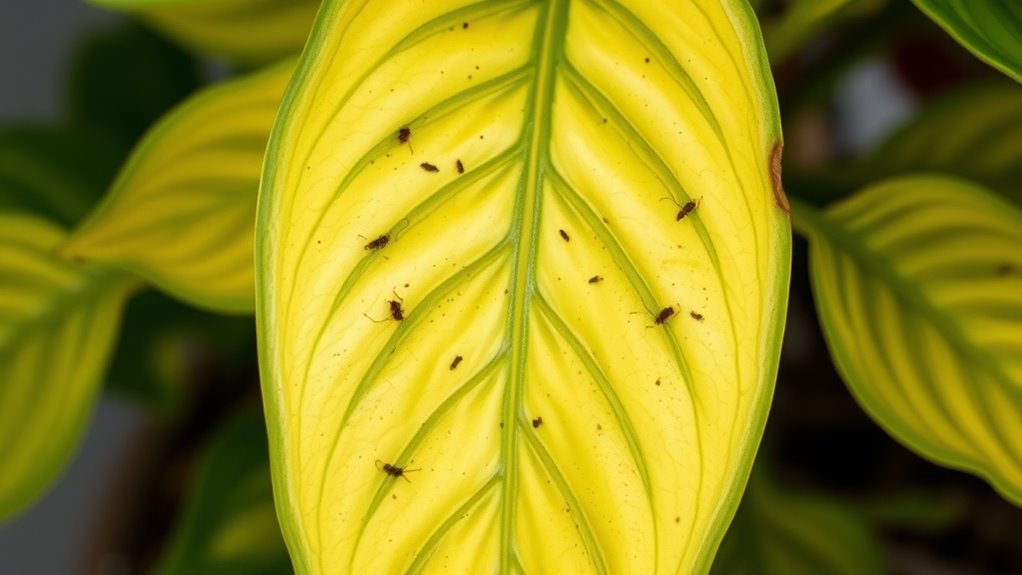
Unusual leaf drop or wilting often signals that leaf miners are disrupting your houseplant’s health. As leaf miners feed inside the leaves, they interfere with nutrient flow, causing stress. This stress appears as wilting or premature leaf drop, which can be mistaken for other issues. Recognizing plant stress indicators helps you act early. Understanding the leaf miner lifecycle shows how their activity damages leaves over time. To help, consider this:
| Symptom | Possible Cause | Action |
|---|---|---|
| Wilting | Leaf miner damage | Inspect leaves for tunnels |
| Drop of older leaves | Plant stress indicators | Remove affected leaves |
| Yellowing leaves | Nutrient disruption | Check for pests and pests’ activity |
Early detection is key to preventing severe damage.
Visible Tiny Larvae Moving Within Leaf Tissue
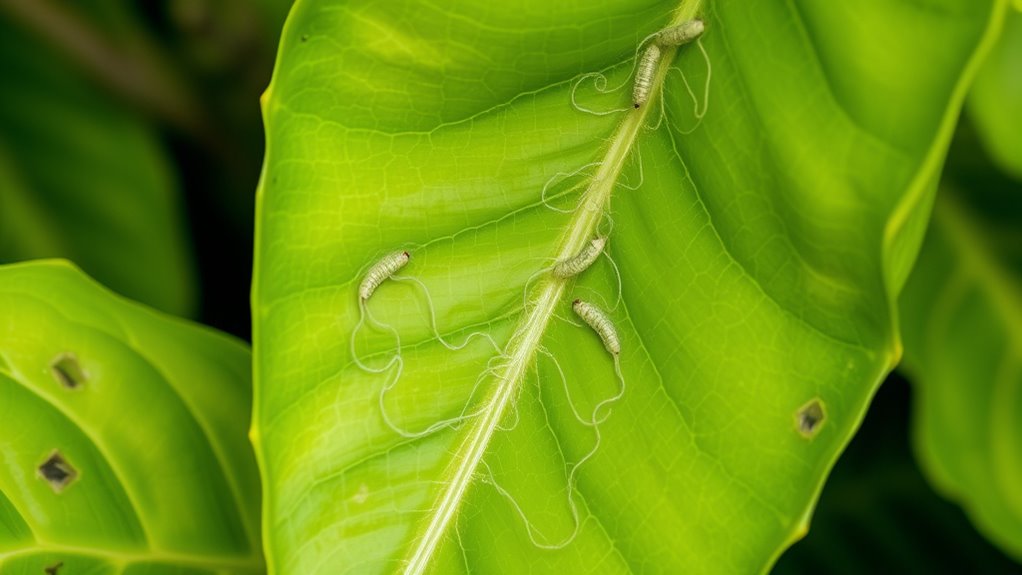
If you look closely at the affected leaves, you may notice tiny larvae moving within the tissue, which is a clear sign of leaf miner activity. These small creatures are part of the leaf miner life cycle and are often hidden beneath the leaf surface. Spotting them can evoke feelings of concern, but it’s also a vital step toward control. Here are some signs to watch for:
- Tiny, winding trails on leaf surfaces
- Suspicious movement beneath the leaf tissue
- Discolored or transparent patches
- Sudden decline in plant health
- Visible larvae when peeling back leaf layers
Understanding the leaf miner life cycle helps you choose effective leaf miner control methods, such as removing affected leaves or using targeted insecticides. Prompt action can save your houseplants from further damage.
Uneven Leaf Growth or Deformation
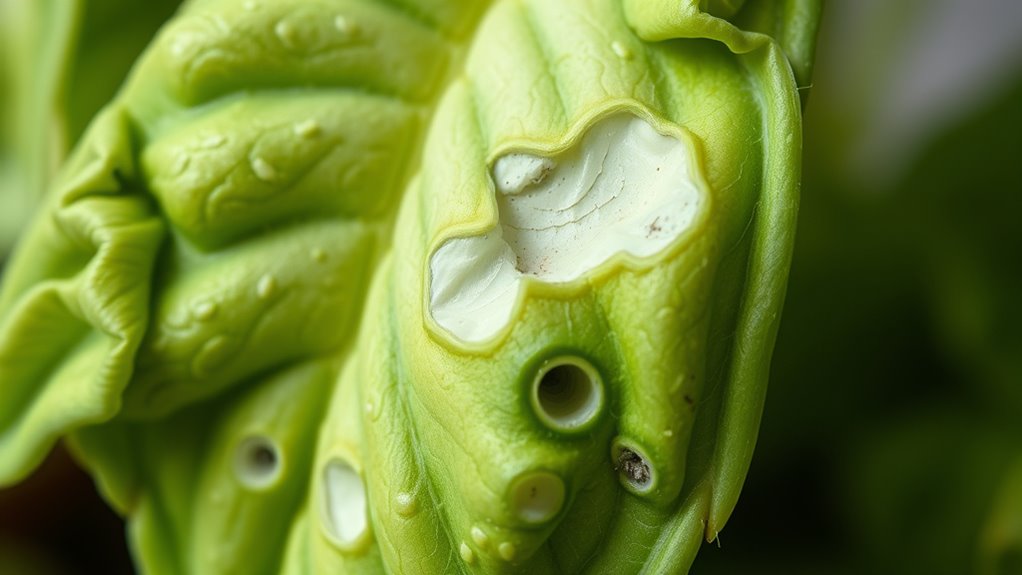
Uneven leaf growth or deformation is a common sign that your houseplant may be suffering from a leaf miner infestation. When larvae tunnel within leaves, they disrupt normal growth, causing distortion, curling, or uneven patches. This damage stems from the leaf miner lifecycle, which involves eggs laid inside leaf tissue, larvae feeding, and pupation. If you notice deformed leaves or irregular growth patterns, inspect closely for tunnels or spots. To prevent further damage, adopt preventive measures like removing affected foliage and controlling pests early. Recognizing these signs allows you to break the leaf miner lifecycle before they cause lasting harm.
| Symptom | Cause | Action |
|---|---|---|
| Deformed, curled leaves | Larvae feeding inside leaves | Remove affected leaves |
| Uneven growth patterns | Disrupted tissue development | Use insecticidal treatments |
| Tunnels or webbing present | Leaf miner activity | Implement preventive measures |
| Discoloration or spots | Damage from larvae | Regular inspection |
Increased Susceptibility to Other Pests or Diseases
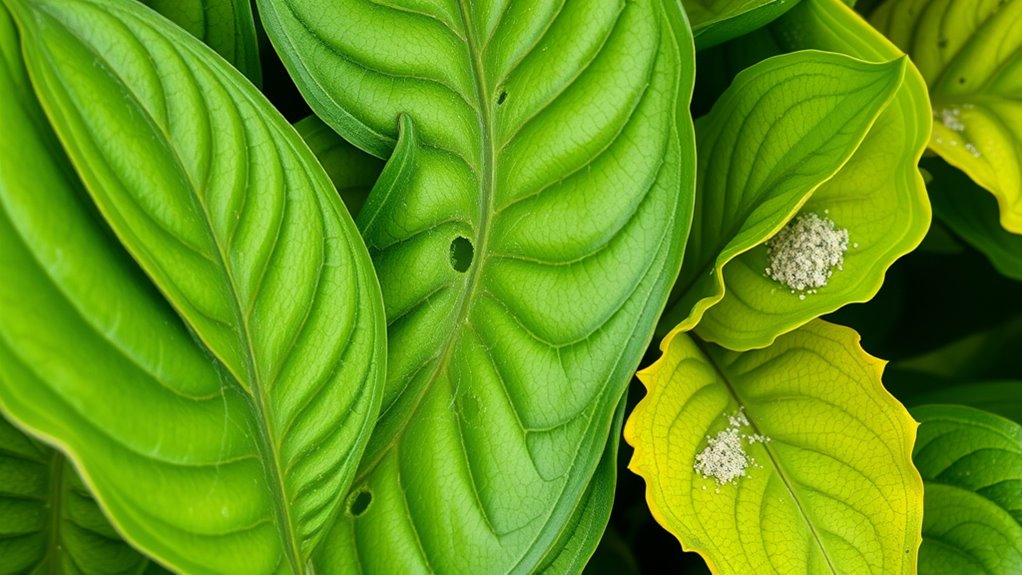
When your houseplants are infested with leaf miners, they become more vulnerable to additional pests and diseases. The damage weakens the plant’s defenses, making it easier for other issues to take hold. You might notice a quick surge in problems like plant nutrient deficiency, which further stresses your plant. Poor watering schedule issues can also compound the damage, creating a perfect environment for fungi or bacteria to thrive. This chain reaction can lead to:
Leaf miner damage weakens plants, increasing vulnerability to pests, diseases, and nutrient deficiencies.
- Rapid spread of pests like aphids or spider mites
- Increased risk of fungal infections
- Wilting and yellowing leaves
- Root rot from overwatering or underwatering
- Overall decline in plant vitality and resilience
Addressing leaf miner infestation promptly helps prevent these cascading problems and keeps your houseplants healthier longer.
Overall Decline in Plant Vigor and Health
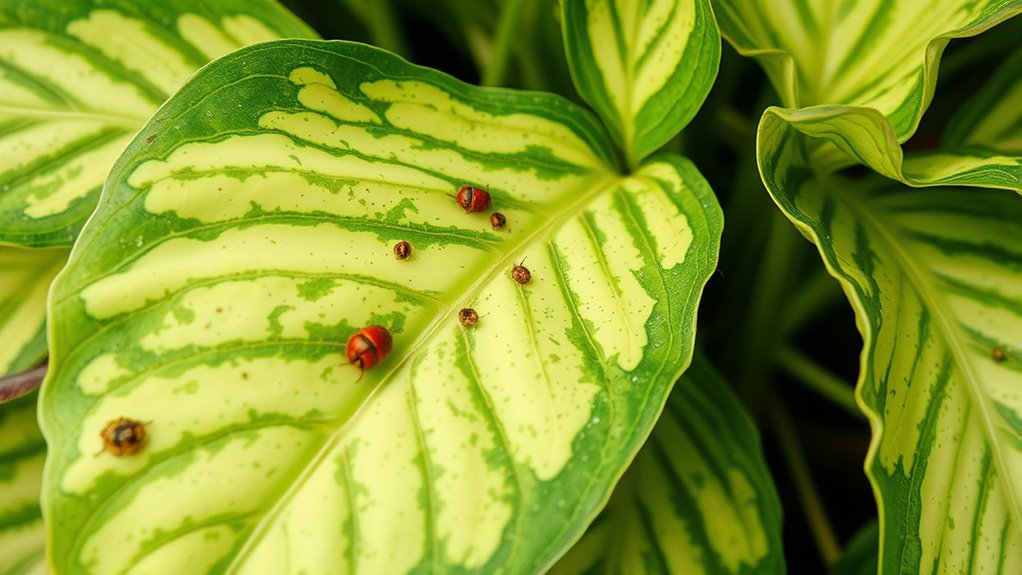
A leaf miner infestation often leads to a noticeable decline in your houseplant’s overall vigor and health. As the pests damage leaves, your plant struggles to perform photosynthesis effectively, which can weaken its growth. Poor plant nutrition, caused by the compromised leaves, further hampers its ability to recover. Additionally, improper watering habits—either overwatering or underwatering—can exacerbate the decline, stressing the plant and making it more vulnerable to pests. You might notice your plant’s leaves turning yellow, wilting, or losing their luster. Over time, this decline can lead to stunted growth or even death if left untreated. To restore health, focus on improving plant nutrition, adjusting watering habits, and addressing the leaf miner problem promptly.
Frequently Asked Questions
Can Leaf Miner Damage Be Reversed in Houseplants?
You can often reverse leaf miner damage in houseplants if you catch it early. Start by removing affected leaves and applying insecticidal soap. Plant quarantine helps prevent spread, and encouraging natural predators like parasitic wasps can control remaining pests. With prompt action, you can restore your plant’s health, but severe damage may be permanent. Regular monitoring and treatment are key to keeping leaf miners at bay.
Are Leaf Miners Dangerous to Pets or Humans?
Think of leaf miners as tiny infiltrators—while they’re more of a nuisance to your plants than a direct threat, you might wonder about pet safety and human health. Fortunately, leaf miners aren’t dangerous to pets or humans; they don’t bite or sting. Still, it’s best to keep infested plants out of reach to prevent accidental ingestion or skin contact. Overall, your health and your pet’s safety remain unaffected by these pests.
How Long Does It Take for Symptoms to Appear After Infestation?
After an infestation begins, symptom development usually takes about one to two weeks. You might notice tiny, winding trails or discoloration on your plant’s leaves within this infestation timeline. The faster you spot these signs, the sooner you can act to control the pests. Keep an eye out for early symptoms so you can intervene before the damage worsens and the infestation spreads further.
What Are the Best Environmentally Friendly Treatment Options?
Like David facing Goliath, you can combat leaf miners with eco-friendly tools. Opt for biodegradable pesticides that break down naturally, minimizing environmental impact. Introduce natural predators such as parasitic wasps to keep pests at bay. These methods are safe for your houseplants and the planet, working together like a well-orchestrated symphony. Stay patient and consistent, and you’ll protect your plants without harming the environment.
Do All Leaf Miners Target Specific Plant Species?
You wonder if all leaf miners target specific plant species. Generally, leaf miner infestation patterns show plant species specificity, meaning certain leaf miners prefer particular plants. Some are more aggressive and can affect multiple species, while others stick to one. Knowing this helps you identify and manage infestations effectively. By observing infestation patterns and understanding plant species specificity, you can choose targeted, eco-friendly control methods to protect your houseplants.
Conclusion
Spotting these leaf miner signs might feel like bad luck, but it’s often a coincidence—you caught the problem early. With quick action, you can save your houseplants before they suffer too much. Pay close attention to those tiny trails and curled leaves; they’re your plant’s way of whispering trouble. Stay vigilant, and you’ll turn this coincidence into a chance to nurture healthier, happier plants.


